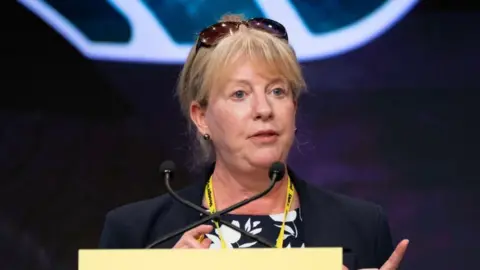How will Scotland plug gaping holes in infrastructure plans?
 PA Media
PA MediaThere are gaping holes in plans to build public assets necessary for the Scottish economy and its public services.
They can be seen in the roads programme, some are running many years late; in promised NHS National Treatment Centres, now stalled; and in affordable housing, where housebuilders say already slashed budgets mean delays to 1,800 new homes.
We have been told that some plans set out in the 2021 infrastructure investment programme will be abandoned or postponed, blaming inflation which rose even higher in the past three years for construction than consumer goods.
The calamitous contract to build two CalMac ferries in Port Glasgow soaked a few hundred million, and it’s not over yet.
There's a catch. Another change in rules to reassure those markets will mean the other big part of a government's budget - current or revenue or, for simplicity, day-to-day spending - cannot be funded by borrowing.
That signals a likely rise in tax in the UK budget next week, and some tough decisions on spending.
Those decisions on public services and welfare will also be passed on to the Scottish government, and will be a focus of the draft budget to be set out by Scotland's finance secretary Shona Robison on 4 December.
There are two other cards she could play.
One would be to raid the windfall takings from auctioning the rights to develop sections of the seabed around Scotland.
She has said around £500m of the ScotWind fund could be in play for this year's shortfalls, which brought strong criticism of using windfall funds in one year to plug a recurring gap each year.
Such funds were meant to be used to invest as capital and infrastructure for the energy transition, but Rachel Reeves' change of rules may limit Holyrood's need to plunder that fund.
 Getty Images
Getty ImagesLooking beyond this year, and probably into 2026 and after, she has newly set out another option - to deploy private finance to build assets, which would then be leased back to the Scottish government.
If you recall that First Minister John Swinney used to be a trenchant critic of the use of private finance for government projects, then you'd be correct. When he led the party from opposition 21 years ago, it was the main plank of his Holyrood election campaign.
But in government, the SNP has used a modified form of private finance, intended to remove the excess profits from contracts.
Some say it has pushed so hard to reduce profit and shift risk that construction companies have become reluctant to take on a Scottish government project, particularly in road building. The drive may have backfired in reducing the competition for contracts.
That helps explain why the latest contract signed for dualling the A9, on a six-mile section between Aviemore and Inverness, has gone more than 50% over its initial budget, to £300m.
Private finance could be an answer to the A9 challenge. It's also seen as a potential solution to the expensive capital project of improving the A96 between Inverness and Aberdeen, and perhaps the notoriously unreliable road over the Rest and Be Thankful pass that links much of Argyll with the central belt.
It could be used to expand kitchen capacity in schools for more free school meals, if they can be afforded, and for the expansion of pre-school child care.
But the Mutual Investment Model (MIM) being considered is only suitable for relatively simple finances - unlike hospitals and schools, where the model has been for private companies to build and then run the facility, extracting profit over 25 or so years.
MIM involves the setting up of a company jointly owned by the private construction/finance companies and by government. Any profits are shared.
Shona Robison points to the Welsh government as a model of how to do this for transport and a health project, generating what she calls 'social benefit'.
The proposal is being tested by the Scottish Futures Trust, the low-profile government agency that has built up a centralised specialism in financing of public projects.
It reports back next spring on use of the Mutual Investment Model to help out the capital budget shortfalls. By that time, Shona Robison expects to know the capital available to Holyrood from the longer-term spending review covering several years from April 2026.
It's not her preferred model, she told me. That remains conventional capital funding.
Yes, the payment for leases over 25 years means a squeeze on the day-to-day budgets for public services and on Holyrood's devolved benefit payments.
There's a reassurance from the finance secretary it will be tested for affordability and value for money.
But it might be necessary to help plug those big gaps.
 PA Media
PA MediaShona Robison also blames the squeeze on capital budgets which has been passed on to her by Chancellors in the UK treasury.
But as she dials down the rhetoric against Westminster in the interests of a better relationship with the new government, she may have two solutions to that problem.
One comes from the new Chancellor, Rachel Reeves, with a signal that she's bending the fiscal rules voluntarily inherited by Labour from her Tory predecessor.
By redefining debt, to include a measure of the UK government's assets, the net debt comes down, making it easier to meet the trickiest rule, which is that debt should falling, as a share of national income within five years.
Without that deft move of the goalposts, she would be unable to provide the investment in public assets with which to meet one of her main targets - faster growth in the UK economy.
That ought to flow through to the block grant the Treasury passes to the Scottish government. So Shona Robison can expect a bigger capital budget than she would otherwise have for next year.
That's welcome, says the Scottish finance secretary, calling on the Chancellor "to waste no time and ensure next week’s Budget not only reverses the cuts to Scotland’s capital funding, but significantly enhances it.
"This will enable us to invest more in infrastructure to support economic growth and net zero, and support our action to tackle child poverty.
“We await next week’s budget to see if Scotland will finally receive the funding it deserves to protect and improve public services.”
